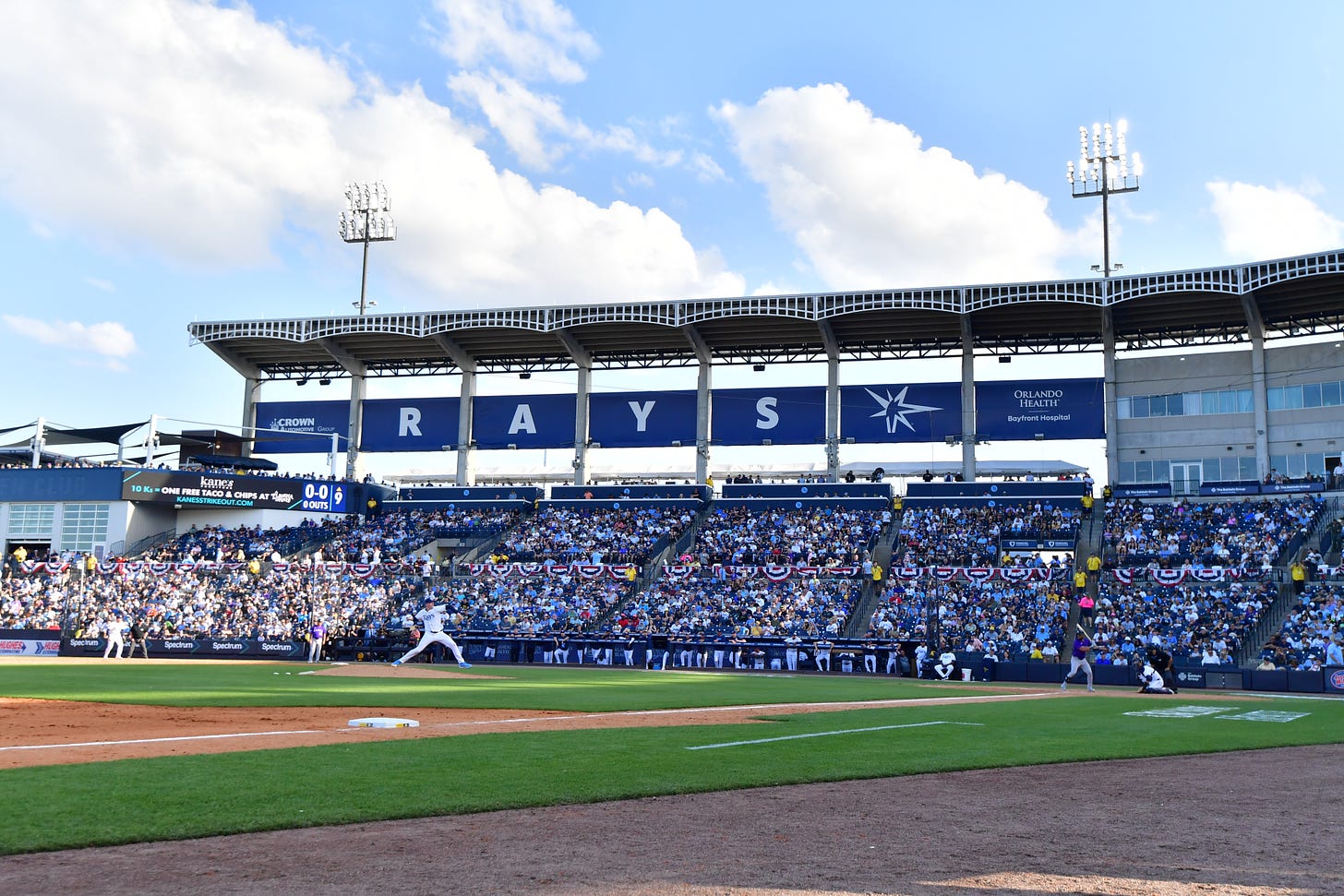Can MLB’s Orphans Write a New Kind of Underdog Story?
Forget "Moneyball". The A's and Rays are simply trying to survive two of the strangest seasons in modern baseball history.

There are MLB teams facing uncertainty in 2025… and then there are the Tampa Bay Rays and Oakland Athletics.
Each club lost its home since the end of the 2024 season — the Rays because Hurricane Milton wrecked Tropicana Field, and the A’s because owner John Fisher pathetically mismanaged the team’s attempted move to Las Vegas, resulting in it having to play in Sacramento for at least the next three seasons. Now both teams will be playing at minor-league ballparks in front of far fewer fans than anybody else in the league:
The Athletics’ ugly exit from Oakland is one of the saddest sagas in baseball history, but the symbolism of the Rays’ situation is pitiful in its own way:
The common thread connecting the Rays and A’s extends beyond their improvised current park setups, of course.
For one thing, these are arguably the two pluckiest underdog franchises in recent baseball history. After actually building the highest payroll in baseball in the early 1990s, the A’s spent the rest of the decade — and beyond — winning in spite of having to pinch pennies, as famously depicted in Michael Lewis’ bestselling book (and later movie) Moneyball. And while the Rays never quite received the same silver-screen treatment, they in some ways were an even greater embodiment of the Moneyball ethos — using analytics to experiment with tactics and relentlessly search for market inefficiencies.
If we plot actual wins from 1998-2024 against what we would expect based on each team’s yearly payroll,1 the A’s exceeded their expected win total by 194 — the best mark in baseball, no surprise to longtime FiveThirtyEight readers — and the Rays rank fifth with 113 extra wins:
(Who were the other three teams? The Braves, Cardinals and Indians/Guardians — the first two of whom were often held up as bastions of traditional team-building during the Moneyball era. In that way, the A’s and Rays’ stories probably punched above their weight some among more data-focused media members because they were on the side of the numbers in the silly beef between scouts and stats.)2
Because of former Athletics GM Billy Beane’s massive influence on all subsequent sabermetric-minded front office members — including Andrew Friedman, the man who molded Tampa Bay into an formidable analytics shop that belied their otherwise miserly status (before leaving for the big-money Dodgers) — the Rays and A’s have always felt like spiritual cousins. They even crossed paths once in the postseason, when Oakland beat Tampa in the 2019 AL Wild Card Game — a fittingly low-budget clash of small-market efficiency that saw the students (Rays) defeat the teachers (A’s).
Now, just six years later, both teams find themselves not only scrapping for wins on the cheap, but also fighting for basic survival without real homes to call their own, playing out maybe the strangest pair of seasons we’ve seen happen in parallel.
Is there hope for either team to write a new type of feel-good blockbuster script for themselves this season? The Rays are off to a 3-1 start and have the third-best BaseRuns predicted winning percentage of any team this season… but they still have a lot to prove after collapsing from 99 to 80 wins last season, then losing two of their best players by Wins Above Replacement (Isaac Paredes and Jose Siri) over the offseason. And the A’s have been all over the place, blasting the Mariners in Seattle and then getting destroyed by the Cubs at “home” within the span of three days.
A lot might come down too how resilient the Rays and A’s are as road warriors — even when nominally at home. And in that regard, Tampa Bay might have a bit of an advantage. Last year, the Rays won pretty much as often on the road as we would expect based on their home record, while the A’s had a fairly pronounced negative gap between their expected and actual road records:
On top of the dueling identity crises, both rosters have seen better days talent-wise, so it’s probably going to take a Hollywood ending for either the Rays or A’s to overcome what they have stacked against them. The Elo forecast model currently gives Tampa a 48 percent chance to make the playoffs, and the Athletics a 14 percent chance. But if one or both could actually pull it off, it wouldn’t just be another Moneyball tale — it would be a miraculous small-market survival story for the ages.
Filed under: Baseball
Based on a linear regression for each season between payroll and wins.
And the Guardians were likely ignored because it’s Cleveland.





My one good friend in St Pete is a Rays season ticket holder — I have to touch base with him to see how he’s holding up. He was no more than five minutes from his front door to the Trop, but boy will he be sour about having to cross the bridge and hit real traffic .The pity is that the nicest spring training venue from bygone days, Al Lang park on St Pete’s waterfront, was converted to soccer years back and unavailable—about a mile from the Trop and just a gorgeous historic ballpark.